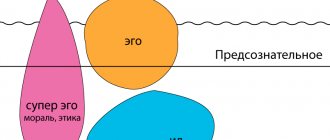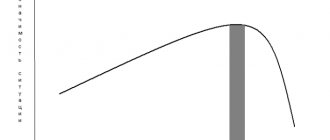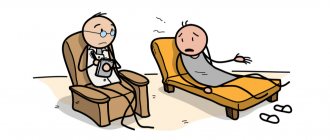The great minds of our planet have been studying the structure of the human personality for many decades. But there are many different questions that scientists cannot answer. Why do people have dreams and what information do they carry? Why can events of past years cause a certain emotional state and provoke rash actions? Why does a person try to save a hopeless marriage and not let go of his half? In order to answer questions related to psychic reality, the technique of psychoanalysis is used. Freud's psychoanalytic theory is the main topic of this article.
The founder of psychoanalysis is Sigmund Freud
What is psychoanalysis
Psychoanalysis
is a theory founded by Sigmund Freud, as well as a method for eliminating psychological problems.
When developing the theory, the famous Austrian psychotherapist used many years of experience gained during his medical practice.
So, what do the basic principles of psychoanalysis say?
:
- Conflicts between the conscious and unconscious can lead to neuroses, fears, depression and other mental disorders.
- A person’s experience, knowledge and behavior are formed on the basis of his irrational unconscious drives.
- An individual trying to realize these drives “turns on” defense mechanisms that interfere with the process of awareness.
- The influence of the unconscious can be neutralized through its awareness. Psychoanalysis is a therapy that involves solving a problem.
The key idea of psychoanalysis comes down to the statement that a person is not aware of his own motives for behavior - they need interpretation. According to Freud's classical psychoanalysis, the patient should voice all his thoughts, associations, and dreams. The task of a psychoanalyst is to analyze what he hears.
What are the alternatives to psychoanalysis?
Psychoanalysts, unlike psychologists, are not oriented Kudryashov I. S. Psychoanalysis and its prerequisites. Journal of Siberian Medical Sciences. on the natural sciences model in assessing human behavior. In psychoanalysis, a person is not an object, but a subject of study, that is, he studies himself. Therefore, according to supporters of psychoanalytic theory, already accumulated knowledge is not applicable to the study of each individual case.
In fact, an alternative to psychoanalysis was Ackerman CE Psychoanalysis: A Brief History of Freud's Psychoanalytic Theory. Positive Psychology. psychotherapy. It relies on evidence-based methods and is less specific about each individual case. And while a psychotherapist may use several types of treatment, a psychoanalyst usually sticks only to psychoanalysis.
Methods of therapy alternative to psychoanalysis (cognitive, cognitive-behavioral, problem) are focused on McLeod S. Psychoanalysis. Simply Psychology. on reducing negative effects. Psychoanalysis seeks Ackerman CE Psychoanalysis: A Brief History of Freud's Psychoanalytic Theory. Positive Psychology. help a person completely overcome the destructive influence of the unconscious by discovering the original source of the problem.
Psychoanalysis had a huge impact on psychology and psychiatry, but it must be understood that it was a product of its time. Freud's concept was extremely lacking in evidence of effectiveness - the students of the Austrian psychologist had to look for them. And although Freudianism is actively criticized, it served as the foundation for evidence-based psychology, which is so popular now.
History of psychoanalysis
The history of psychoanalysis dates back to 1880, in the days when the Viennese physician J. Breuer shared with his comrade S. Freud a remarkable story about a patient who was cured of the symptoms of hysteria after a hypnosis session. At the reception, she was able to voice a deeply traumatic event that happened to her. The result was a strong emotional reaction. Catharsis resulted in a significant reduction in symptoms. When the patient emerged from the hypnosis state, she had no memory of her confessions.
Freud decided to apply the technique with his patients - Breuer's results were confirmed. The partners shared their findings in a joint publication, Research on Hysteria, arguing that the symptoms of hysteria are caused by repressed memories of traumatic events. The difficult situation is repressed from consciousness, but continues to influence the patient.
Personal reasons prompted Breuer to withdraw from research and Freud began independent work. He was able to discover that a similar result is achieved not only with hysteria, but also with obsessive states of a sexual nature, often arising in childhood.
The psychoanalyst initially considered the Oedipus complex to be the key cause of neuroses. The symptom begins to form at moments when the child’s unconscious drives threaten to break through the barrier set by repression, which turns out to be unacceptable for other parts of the psyche due to fear of punishment and for moral reasons.
What is the pleasure principle and the reality principle, and what does fantasy have to do with it?
According to the pleasure principle, every desire should be satisfied immediately. Fantasy serves to comply with this principle. From Freud's point of view, fantasy is an unconscious mechanism that is triggered by drive. Under no circumstances should one assume that a person decides what to fantasize about. Fantasy, like drives, is a physiologically conditioned and compulsory thing.
The principle of reality is associated with the fact that over time the child realizes the opportunity to satisfy desires not only fantasy, but also in reality. However, to do this, he needs to overcome certain difficulties, which means sacrificing the immediate satisfaction of desire. This is how the child gradually learns to act in reality.
In adults, the reality principle replaces the pleasure principle. As a consequence, the pleasure principle withdraws into fantasies, the drives stimulate fantasy ways of satisfying them, and the conscious “I,” fully imbued with the reality principle, uses fantasies as material for choosing goals.
Example: let's say a person is hungry. This need arises at the physiological level, but then the imagination begins to sort out possible ways to satisfy hunger: go to an expensive restaurant, to a simple cafe, to a buffet, to home, to cook soup, to make a sandwich.
From the point of view of fantasy, Freud emphasizes, all options are equivalent, because it has no idea of obstacles. Taking into account obstacles is a matter of the reality principle. The reality principle should weed out those options that seem unacceptable (for example, going to an expensive restaurant or making a unhealthy sandwich). Already at the conscious level, the “I” may hesitate for some time between several acceptable options, but then it makes a decision and transfers it to the level of an action program.
Basics of psychoanalysis
Psychoanalysis is a therapy based on several immutable principles
:
- First of all, the principle of determinism is implied. According to the ideas of psychoanalysis, not a single manifestation of the psyche can be called random, unrelated to anything, or involuntary. Conscious feelings, thoughts, impulses should be considered as events of cause-and-effect interactions determined by early childhood experience. Special research methods (mainly through dream analysis and associations) reveal the connection between situations from the past and current psychological experience.
- The basis of the second principle was the topographical approach. All mental elements are assessed according to the criteria of their accessibility. Repression, which ensures the removal of certain psychological elements from consciousness, indicates that a certain part of the psyche is making efforts without wanting to realize them.
- The third dynamic principle is based on the theory that the psyche is driven to action by impulses of aggression and sexuality, which are elements of a common biological heritage. They have significant differences from the instinctive behavior of animals. In the animal world, a stereotypical response is usually recorded, provoked by special stimuli in certain situations and aimed at survival. Psychoanalysis considers attraction as a state of nervous excitement, which is a response to stimuli that direct the psyche to action and relieve tension.
- The fourth principle is the genetic approach. The personality traits of an adult, characterizing his conflicts and neurotic symptoms, are generally associated with the fantasies and desires of childhood. It is believed that no matter what paths open to a person, he will not be able to escape from his own childhood experiences - in any case, they will haunt him throughout his life.
What is included in the basis
Consciousness - what is it in psychology
Briefly, psychoanalysis can be presented as a method for studying psychological processes that are beyond consciousness. The theory takes into account the interrelation of all hypotheses about the functions and structure of the mental apparatus and considers them as a whole.
Modern psychoanalysis is based on the following areas:
- A theory that defines the behavior and development of an individual;
- Research of motives through free associations, interpretation of dreams. This allows us to bring out the hidden prerequisites that led to mental disorder;
- Treatment method, including:
- transfer and resistance analysis;
- interpretation of the source of conflicts (interpretation);
- elaboration as the final stage, leading to a restructuring of the psyche.
The main goal of the analyst is to rid the psyche of the subject of the hidden mechanisms that gave rise to conflict situations. This allows you to redirect the patient to the realization of positive desires and help him adapt to society.
What is hidden beyond consciousness
Additional Information. During the psychodynamic approach, the specialist tries to make the patient aware of the existence of unconscious conflicts, thereby influencing behavior and personal relationships.
Methods of psychoanalysis
Let us consider in detail the main methods used in the field of psychoanalysis: the method of dream interpretation, the method of free association, the method of interpretation. Let's describe each one separately.
Free association method
What is this famous method based on? On the use of the phenomenon of associative thinking in order to study deep mental phenomena and processes (often they are unconscious). The data obtained are used for the treatment and correction of functional mental disorders, with the help of the patient’s awareness of the nature and source of the problems.
What is special about the free association method? In a conscious joint and purposeful confrontation between the therapist and the patient with a state of psychological discomfort. Acting together, the psychoanalyst and the patient cope with the problem.
The method of free association can be called a method for studying the mental state of a patient. He talks about any thoughts that come into his head, no matter how absurd or inappropriate they may seem. They may sound fantastic, ordinary, obscene. The therapist has to draw a conclusion from these revelations or incoherent fragments of thoughts.
In the “Dictionary of Psychoanalysis” (J.B. Pontalis, J. Laplanche) it is noted that free associations can be called the expression of all indiscriminately ideas and thoughts that arise in the mind - spontaneously or starting from any element (number, word, image from a dream).
Freud called for abandoning the role of controlled consciousness, beginning to understand mental processes. He stated that consciousness tries to eliminate images and thoughts that appear on the periphery before the attention of the analyzing object is focused on them. Moreover, when analyzing the mental state, it is these images and thoughts that can carry special meaning.
It was Freud who first began to actively use the method of free association. The psychoanalyst suggested that his patients lie down on the couch and relax, simply saying whatever came to their mind, no matter how incredible, absurd and unusual these thoughts were from the point of view of usual moral standards. During the sessions, the therapist observed how powerful emotional drives led uncontrolled thinking to mental conflict. The famous psychotherapist stated that the first random image and thought implies exactly what is needed for psychoanalysis. A random thought may have a connection to a repressed memory.
Dream interpretation method
According to the theories of Sigmund Freud, dreams can reveal the presence of intense mental activity in the depths of consciousness. What is dream analysis? The therapist must find the distorted unconscious truth hidden in every dream. Freud was convinced: the stranger and more confusing the dream, the more hidden content it contains. In the language of psychoanalysis, this phenomenon is called resistance - its manifestations can be noticed even when the person who saw the dream does not agree to its interpretation. This speaks of his unconscious resistance, established barriers to protect his own psyche.
Dreams separate the unconscious from the real world. In them, exciting situations that cause emotions are deformed in the most bizarre way. Dreams can also tell about secret desires. In the case of child psychoanalysis, the differences between hidden and overt thoughts are less clear.
Hidden thoughts are transformed into symbols, appearing in a form acceptable to consciousness. This allows them to bypass certain "censorship". Even today, the manifestation of the unconscious in the form of dreams remains one of the greatest mysteries of consciousness.
The method of dream interpretation is very important - it allows you to identify the essence of the images that appear in a dream. Freud processed dreams by positioning them as symptoms of illness. According to him, for the correct use of this method, it is not recommended to consider dreams as something single - such an analysis will not lead to anything worthwhile. He was convinced: when analyzing dreams, it is necessary to painstakingly study its elements separately. The association rule should be applied to individual fragments. Freud considered any dream not only an object worthy of scientific research, but also a way to know one’s deep essence, to discover hidden desires that do not appear on the surface.
Interpretation method
Interpretation is considered one of the most important tools of any analyst. Even in the interpretation of dreams and free associations, interpretations are used by the therapist. What does this term mean?
Interpretation is called the main analytical tool. In dream interpretation and free association, the psychoanalyst attempts to use interpretations. We are talking about transferring significant information about the patient from the unconscious level to the conscious level. Repressing information that causes concern and anxiety in an individual, as well as its correct analysis, will soften the symptoms of neurosis or other mental problems.
Summarizing
Freud's theory of psychoanalysis was briefly and clearly presented in this article. To summarize, we can say that this method is one of the attempts to understand those features of the human psyche that were previously incomprehensible . In the modern world, the term “psychoanalysis” is used in the following areas:
- As the name of a scientific discipline.
- A collective name for a set of events dedicated to research into the functioning of the psyche.
- As a method of treating neurotic disorders.
Many modern scientists often criticize Sigmund Freud's theory. However, today, the concepts that were introduced by these scientists are a kind of basis for the science of psychology.
Psychoanalysis in psychology and philosophy
One can hear many general statements about psychoanalysis. It is usually noted that psychoanalysis is a well-known direction in psychology, the benefits and significance of which are assessed differently. The method has both supporters and opponents.
If we talk about psychoanalysis in a philosophical vein, it is noted that a feature of psychoanalytic concepts is their connection with psychotherapeutic practice. It is not reduced to either experimental knowledge or philosophical speculation, but grows from the experience of communication and other aspects. Real comprehension of your inner world is achieved through insight. Such insight brings changes to the patient’s life - he begins to think about himself and his beliefs in a completely different way.
This philosophy is somewhat similar to ancient teachings that combined the theory and practice of Zen Buddhism, yoga and other types of mental self-regulation.
The practice of psychoanalysis is periodically compared with the healing actions of priests and shamans. Training in psychoanalysis is equated to initiation. It is no coincidence that many famous analysts who practice psychoanalysis simultaneously show interest in various Eastern teachings and even magic.
Most adherents of Freud's theories, as before, adhere to the model of the human psyche that was supported by the “father of psychoanalysis.” Their beliefs are based on the fact that psychoanalysts usually receive psychological or medical training. Their task is to adapt the patient to surrounding circumstances. To a large extent, psychoanalysis is widespread in America and the most developed European countries.
At one time, Sigmund Freud still hoped that his theories of psychoanalysis would be recognized by the scientific community. For this purpose, he resorted to analogies with archeology, hydraulics, economics and other sciences. Gradually, the conviction began to grow stronger in him that this would not happen after all.
The first reason can be called the difference in approaches, and the second is that for scientists, whose formation took place in the scientific fields of the nineteenth century, psychoanalysis is an unacceptable aspect for personal reasons. The ideas of therapy ran counter to narcissistic illusions about the power of the mind over nature and oneself. In general, the frequency with which many representatives of science and philosophy condemned the principles of psychoanalysis indicates their obvious bias. Gradually these beliefs began to change.
Today, the scientific status of psychoanalysis periodically continues to be challenged. Some researchers are inclined to think that it is still scientific, others question this statement, calling the well-known therapy pseudoscience.
However, in the twentieth century, psychoanalysis became widespread in the humanities, psychology, philosophy and other fields.
Personal defense mechanisms
Anxiety is a kind of warning that the Ego is in danger. Freud suggested that the Ego erects a kind of barrier against anxiety - defense mechanisms , which represent a subconscious denial or distortion of reality.
Defense mechanisms (psychological defenses of the individual) are certain types of behavior designed to protect the Ego (I) from anxiety generated by conflicts in everyday life.
1. Denial is the process of eliminating, ignoring the traumatic perception of external reality. For example, a terminally ill person denies the inevitability of death.
2. Substitution is the switching of id impulses from one object, inaccessible or fraught with a threat, to another, more accessible one. Those feelings and actions that should have been directed at the object that caused the anxiety are transferred to another object.
For example, replacing hostility towards your boss with pickiness towards your own child. In television reports about football matches, we often see how an attacker, who misses the target, sends the rebounding ball with a strong blow, in any direction. In this way, the accumulated energy is discharged.
3. Projection is a situation in which an anxiety-producing impulse is attributed to someone else. Most often, this is an unconscious mechanism through which impulses and feelings that are unacceptable to the individual are attributed to an external object and penetrate into consciousness as an altered perception of the external world.
He transfers (projects) his own desires, feelings and personality traits, which a person does not want to admit to himself because of their ugliness, onto another person.
For example, someone claims that in fact it is not he who hates his professor, but that he dislikes him. Or a stingy person, who, as a rule, sees in other people primarily greed, and an aggressive personality considers everyone around him to be cruel.
4. Rationalization is the reformulation of behavior in such a way that it becomes more understandable, more acceptable, and therefore less frightening to others. The function of rationalization is to disguise, hide from the consciousness of the subject the true motives of his actions, thoughts and feelings in the name of ensuring internal comfort, preserving self-esteem, self-respect.
Often this mechanism is used by a person to prevent the experience of guilt or shame. When this mechanism operates, the awareness of those motives that appear to be socially unacceptable or disapproved is blocked. A person, after some actions, actions dictated by unconscious motives, tries to understand them and rationally explain them, attributing to them more acceptable, more noble motives.
For example, you could claim that the job you just got fired from wasn't really that good.
5. Reactive formation is the replacement of one Id impulse with another, opposite to the first. A person hides impulses that disturb him by turning them into something opposite (alternatively, he can replace hatred with love). For example, someone who is constantly overcome by the desire to drink alcohol may suddenly become a passionate fighter for the passage of Prohibition.
6. Regression is a psychological defense mechanism consisting in the fact that a person, in his behavior when responding to very important situations, returns to early, childhood types of behavior that were successful at that stage.
The appearance in an adult of traits of childish, dependent behavior associated with happy times.
7. Suppression (repression) is the denial of the existence of some factor or event that causes anxiety. As a result of the action of this defense, thoughts, memories or experiences unacceptable to a person are, as it were, “expelled” from consciousness and transferred to the sphere of the unconscious, but at the same time they continue to influence the behavior of the individual, manifesting themselves in the form of anxiety, fear, etc. For example, involuntary repression from consciousness of certain memories or experiences that cause severe discomfort.
8. Sublimation is a change or replacement of some impulses of the Id through the switching of the energy of instinct to socially acceptable goals. There is a substitution of those needs that cannot be satisfied directly with socially acceptable goals.
For example, the transfer of sexual energy into the sphere of artistic creativity.
9. Identification is a defense mechanism in which a person sees another in himself and transfers to himself the motives and qualities inherent in another person. Identification also has a positive aspect, since with the help of this mechanism the individual assimilates social experience, masters new properties and qualities. For example, when using the identification mechanism, a person imitates the manners of some other person, whom he admires and who seems less vulnerable to him in alarming situations.
Freud's theory of psychoanalysis: briefly
According to Freud's theory, the human psyche can be “divided” into the following components: Ego, Id and Superego.
Definition of terms
:
- The id
is the main source of drive and desire. As an analogy, we can cite an ordinary street dog, where all its actions, such as mating, sleeping, etc., are the result of instincts inherent in nature. - The ego
is a mediator that divides social frameworks and animal instincts. The part of the personality that satisfies the needs of the id, taking into account the limitations of the external world. - The superego
implies all social frameworks, starting with the period of parental education, when the foundations are laid for what can be done and what is unacceptable. In adult life, it is reflected in all aspects of life, such as morality, religion, law.
The topical model of the mental apparatus includes two elements: the unconscious and the conscious.
What do they mean
:
- The unconscious
is psychic forces that are below the level of consciousness. They determine how a person behaves. - Conscious
is a mental aspect that an individual is able to become aware of. Consciousness has a direct impact on how an individual positions himself in society. The psyche can automatically be corrected by the pleasure principle. If the balance is disturbed, then a reset occurs through the unconscious sphere.
Defense mechanisms realize the conflict between the Superego and the Id. Freud described many of them: isolation, projection, repression, denial, substitution, regression and so on.
Resolving intrapersonal conflicts
The human psyche tries to resolve intrapersonal conflicts in various ways:
- Dreams
- Sublimation
- Compensation
- Blocking the defense mechanisms of the psyche
In dreams of desires appear that have not been realized in reality. Recurring dreams indicate dissatisfaction with a certain unrealized need , which serves as an obstacle to human freedom and development. Sublimation is understood as the redirection of internal energy to goals that are encouraged and approved in society. Especially often, these goals correspond to creative activity, socially significant acts of an intellectual nature. The author also understood sublimation as a form of successful protection ; thanks to the influence of this energy, humanity created civilization. Unsatisfied desires often cause a state of anxiety; this is the body’s ability to neutralize the problem by directly addressing it. Energy that cannot find an outlet will become focused on overcoming difficulties, reducing risks and compensating for needs. Compensation means compensation for mental deficiencies. For example, a person with a lack of ability, but with a strong desire to achieve a goal, can develop the skills of performance and assertiveness.
In some situations, the voltage may be distorted or rejected by protection mechanisms . The defensive reaction to the same situation in the psyche can be different .
For example, the reaction to unrequited love feelings can be suppression (“I don’t remember these feelings”), rejection (“I didn’t have those feelings”), rationalization (“This relationship was a mistake”), isolation (“I don’t need these feelings ") and others. In his theory, S. Freud made the greatest attempt to understand and describe the human psyche , and made sensational discoveries in the psychoanalytic direction of psychology. The basic concepts introduced by the scientist are used in science and in the modern world and are the basis of many theories.
Classic psychoanalysis by Sigmund Freud
Having begun to develop a new approach to the treatment of mental problems, Freud initiated his own research and studied the data of other scientists. Nowadays the theory of psychoanalysis is considered truly unique. What distinguishes her from others is that she does not undertake to study individual problems of an individual. Psychoanalysis looks at everything in its entirety. We suggest that you briefly familiarize yourself with the main provisions of therapy.
Classical psychoanalysis is based on the determinism of the biological component - on the assertion that physiological needs suppress all others and indicate their vector. Mental determinism indicates that any incident in a person’s life has its consequences. Each of his actions is determined by an obvious or hidden motive, which was preceded by certain events.
Several aspects of an individual’s mental life are distinguished: conscious, preconscious, unconscious. In the first case, we are talking about experiences and current thoughts, in the second – about secret desires and fantasies, in the third – about what stands out from consciousness, suppressed by the internal censor. Freud believed that psychology should be interested in this complex mechanism in detail.
Stages of personality development according to Freud
Freud believed that libidinal energy, associated with the life instinct, is the main factor in the formation of human character. In its development, a personality goes through several stages, they are associated with a shift in erogenous zones - those areas of the body whose stimulation causes pleasure, hence the name of age stages (stages).
Oral stage (up to 1 year) – during this period, desires are satisfied when the oral cavity is irritated. The child sucks milk, swallows, and when there is no food, sucks his own finger. All the baby’s desires cannot be satisfied, so the first restrictions appear and the Ego (I) begins to form. At the same time, such personality traits as greed, demandingness, insatiability develop, whatever is offered.
Anal stage (1-3 years) – the aerogenic zone moves into the intestinal mucosa. The baby is learning toilet skills. Parents teach neatness, new requirements and prohibitions arise. The Super-ego (Super-I) begins to form as the embodiment of social norms, internal censorship and conscience. During this period, accuracy, punctuality, stubbornness, secrecy, aggressiveness, etc. develop. According to Freud, children should be encouraged to have regular bowel movements and at the same time praised, then the child will develop positive self-esteem and, possibly, creative abilities.
Phallic stage (3-5 years) . The child begins to realize his sexual differences and is interested in the genitals. If before this children's sexuality was directed towards themselves, now children begin to experience sexual attachment to adults. Boys develop the Oedipus complex, girls develop the Electra complex. This is a period of strict prohibitions, when the Superego (Super-I) is intensively formed. New personality traits appear: introspection, prudence.
The latent stage (5-12 years) is a period of sexual calm, especially at 6-7 years. Preparations for growing up are underway. The ego and superego are actively developing. Attractions emanating from the Id (It) are successfully controlled. Children's sexual desires are repressed, and the child's interests are directed in another direction: communicating with friends, studying at school, etc.
The genital stage (from 12 years of age) begins with puberty. All erogenous zones are united, and a desire for normal sexual communication arises. Teenagers experience increased excitability and sexual activity. The id intensifies its action, and the individual has to fight its aggressive impulses using psychological defense mechanisms.
Psychological defense mechanisms
There is an unstable balance between the Id, Ego and Superego. The id sends out instincts that need to be satisfied. But some desires do not correspond to moral standards. The superego monitors compliance with these norms and inhibits desires. A compromise between them is achieved at the expense of the Ego. When an internal conflict is not resolved for a long time, a person becomes neurotic, because... He can maintain his mental state only thanks to psychological defense mechanisms. Each person has his own set of such mechanisms. Freud identified 5 of them.
Crowding out . When unacceptable desires (memories, thoughts, experiences, etc.) are repressed into the unconscious. Gradually a person forgets about such a desire, but the tension remains. Penetrating through the unconscious, it reminds itself of itself in the form of symbols in dreams, slips of the tongue, mistakes, etc.
Regression. Psychological defense, expressed in a return to childhood behavior patterns and habits: biting nails, spoiling things, being capricious, etc. In adults, it may include dissatisfaction, incontinence, desire for risky situations, opposition to authorities, etc.
Rationalization is a disguise. Avoiding true thoughts and feelings through more acceptable explanations of one’s own behavior. This suppresses guilt and shame, preserves self-esteem, and achieves a state of inner comfort. These “rational” explanations often look stupid and illogical
Projection is the unconscious or conscious transfer by a person of his states to external objects or the attribution of his own desires and feelings to other people. In other words, the blame for what happens is always placed on another person or circumstance.
Sublimation . When there is sexual or aggressive desire, the desire is directed in a different direction. Thanks to the sublimation of sexual desire, creative people can experience an extraordinary rise, masterpieces of painting or music are created, discoveries are made in the scientific field, etc.
Psychoanalysis of modern times
Sigmund Freud was convinced that all our actions are dictated by subconscious desires. Particular emphasis was placed on the fact that emerging needs are based on physiology and sexual desires. Modern psychology no longer focuses on this and does not pay too much attention to the statement.
How widespread is psychoanalysis today? In many countries it is quite developed, being quite an ordinary phenomenon. Many modern therapists write books on this topic, which are very popular - that is, it is in demand. Of course, a certain type of society has long resisted the principles of psychoanalysis, not accepting them. This can be said about Germany during the period of National Socialism and the USSR before the Brezhnev stagnation. These examples are the most obvious. Both the fascist and communist regimes opposed Freud's teachings on ideological grounds. The Germans considered these theories “Jewish science that degrades human dignity,” and the Soviet Union considered these theories “the apotheosis of bourgeois individualism.”
Both hidden attempts to oust the teaching from the life of society and obvious repressions against it are known. It is worth recognizing that psychoanalysis also runs counter to many religion-centered and theocratic societies. Although there are cases when it was successfully developed in countries with authoritarian political regimes. The most obvious example is Argentina. According to the assumption of the Argentine psychotherapist A. Benjamin, the reason is that it was the psychologist’s office that usually became the last refuge for oppressed citizens, where freedom of speech was not prohibited.
To summarize, the conclusion suggests itself that freedom is considered the main condition for the successful development of psychoanalysis in society. Let us clarify that in this case, society should share the value of freedom, it should demonstrate the real implementation of freedoms (personality, speech, thought). By the way, for the full development of psychoanalysis, freedom of association is required, which makes it possible for the corresponding community to take shape.
In general, psychoanalysis is quite common in modern society. Various trainings are conducted, therapeutic rooms operate, and relevant literature is published.
Freud's structural model of personality
Freud believed that a mature personality consists of three principles: Id (It), Ego (I), Superego (Super-I).
The id (It) represents the primitive, innate and instinctive aspects of the personality, it functions in the unconscious and is associated with biological drives (sleep, food, defecation, etc.), filling human behavior with energy. The id contains passions, and as a biological principle it is irrational and immoral. The id obeys the pleasure principle and maintains a central position for the individual throughout life. According to Freud, the Id (It) is something dark, biological, not regulated by laws or rules. This is the initial structure of the psyche, which provides a discharge of psychic energy, but this happens in an impulsive and irrational form.
Ego (I) is a set of cognitive and executive functions of the psyche, conscious of a person, responsible for making decisions. The ego satisfies the desires of the id to the extent that real circumstances allow and is guided by the restrictions imposed by the external world. That is, no matter what your desires are, you must take reality into account and tolerate the postponement of your needs until acceptable conditions are created. The release of libidinal energy is inhibited or directed in another direction, acceptable for the given situation.
The superego (Super-I) is the bearer of moral standards, the critic and censor of all human desires. The superego is formed under the influence of society on the consciousness and subconscious of a person, his acceptance of values and norms of public morality. The main source of the formation of the superego are parents, loved ones, teachers and educators, those people with whom a person enters into long-term relationships throughout his life.
How do the Id, Ego and Superego interact?
Once born, a child has only the Id (It) and lives according to the principle of pleasure. When he faces prohibitions from his parents and people around him, he develops as a person and the Ego (I) and Super-ego (Super-Ego) appear. Consequently, under the pressure of the society in which he lives, he has an antagonistic relationship with it, but without this pressure personal growth is impossible.
According to Freud, the id requires the satisfaction of instincts, unconsciously directs psychic energy to regulate mental processes and human states. The unconscious drives that the Id sends are in constant conflict with the Superego, i.e. with moral standards. The constant contradictions between them are resolved by the Ego (I). The ego reconciles both sides so that the drives of the id are satisfied, but moral standards are not violated.
Freud's model of personality (Id, Ego, Superego) is divided into three zones: the unconscious, the preconscious and the conscious. Consciousness is the top, the preconscious and unconscious are the “underwater” part. The id is completely unconscious and inaccessible to consciousness. The superego is formed in the process of interaction with surrounding people and society. The content of the preconscious can be realized by a person, but it requires effort. The mechanism for the formation of the Super-ego in a child is identification with a close adult by gender, whose traits and qualities become the content of the Super-ego. The development of the psyche and superego in children goes through overcoming the Oedipus complex in boys and the Electra complex in girls.
Oedipus complex in boys and Electra complex in girls
According to Greek mythology, King Oedipus killed his father and married his mother, not knowing that she was his mother. Freud believed that the Oedipus complex conceals the essence of the sexual complex that constantly gravitates over every man. That is, the boy is attracted to his mother, and considers his father a rival - this causes admiration, fear, and hatred in the child. He wants to be like his father, but at the same time he wants his death, fearing castration for his attraction to his mother. Overcoming the Oedipus complex in boys occurs at the age of 5-6 years. At this time, their super-ego is formed.
The Electra complex in girls is associated with craving for the father and hostility towards the mother, and develops at the age of 5-6 years. The appearance of this complex is also associated with Greek mythology and is reflected in the behavior of Electra, who persuades her brother Orestes to kill her mother and her lover, thereby avenging the death of her father. Girls' first love is for their mother. But subsequently she sees a physical difference in the structure of the body, she does not have a penis, like her father and brother, and envy develops, which is the mental analogue of castration fear for boys.
Conclusion
The ongoing debate about the validity of Freud's theory of personality development should come as no surprise. It should come as no surprise that most people defend themselves against Freud's incriminating concepts. Freud himself believed that he was destined by fate to interrupt the “sleep” of humanity and tell them such an unpleasant truth about himself. As the great psychiatrist once told the writer Zweig, the main task of his theory is to teach a person to fight the “demon of irrationality”, while using the most rational principles of his mind.
Freud was very proud of his reputation as a “destroyer of illusions.” The product of his research work - psychoanalysis - became the main enemy of the deceitful politeness and secrecy of the society of that time. In 1930, in a letter to Albert Einstein, Freud wrote: “I no longer consider it one of my virtues that I always tell the truth whenever possible; it became my profession.”
Childhood development and adult psychological conflicts
Freud considered childhood to be the period of life that has the most powerful influence on the development of the character of an adult. The famous psychiatrist was convinced that all the most important things in a person are formed before he reaches 5 years of age. Then he lives, trying to eliminate the conflicts of the past. “The secret of the human soul lies in the psychic dramas of childhood. Get to the bottom of these dramas, and healing will come,” Freud said.
Therefore, Freud's theory of personality development does not distinguish any special phases in adulthood. All symptoms of adult neuroses can be interpreted as a conflict between the Superego and the Id. The last part strives for sexual release, the first has the function of suppression. The “superego” makes a person feel guilty even if the discharge of the “Id” occurs symbolically.
Freud identified two types of neurotic disorders associated with a conflict situation in the present tense: neurasthenia, which is acquired as a result of excesses in sexual life, and anxiety neurosis, which occurs as a result of excessive suppression of sexual desires.
The origins of smoking addiction
Freud divided mental development into stages depending on the method of obtaining pleasure. He called the first oral - the stage of receiving pleasure using the mouth area. Babies, feeding on milk from the mother's breast, stimulate the oral cavity. In the process of satiation, they develop a feeling of satisfaction, and it is automatically associated with swallowing, chewing, and licking.
Freud believed that smoking addiction occurs in people who need to satisfy their needs, but have the ability to realize them. These people mentally return to the first stage of development and unconsciously strive to influence the oral cavity.
Freud once stated that women's addiction to smoking is a subconscious desire for oral sex. The scientist himself suffered from nicotine addiction, and his students immediately reminded him of this, hoping to confuse him. In response to this, Freud said his famous phrase, which later became a catchphrase: “Sometimes a cigar is just a cigar.”











